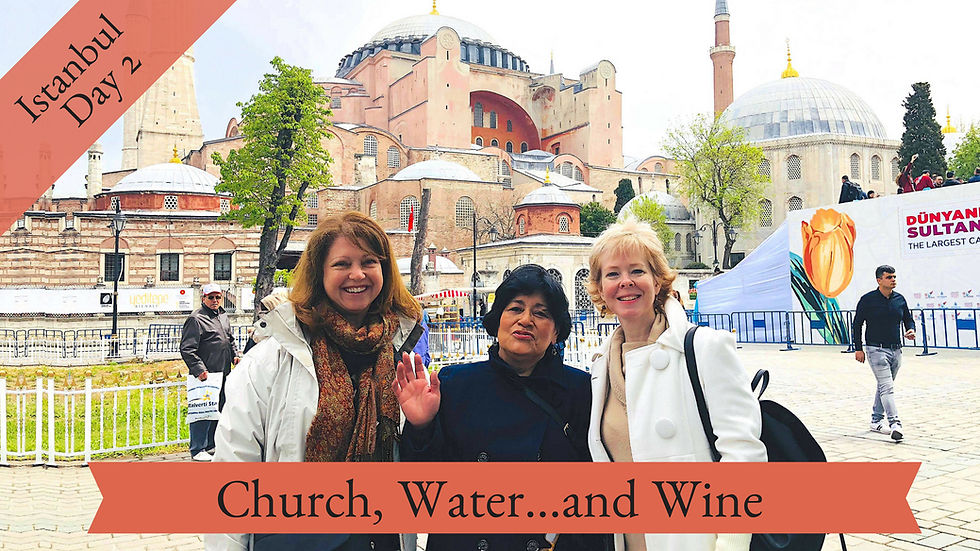The Great Hippodrome
- Ginger Monette
- Apr 3, 2018
- 4 min read
Updated: Oct 18, 2020

I'm off to Turkey next month and decided some research would help me fully appreciate the country's rich history and sites.
I began with an overview of Turkey's History, posted here. While reacquainting myself with The Byzantine Empire, Constantinople, and The Crusades, I stumbled onto a documentary on the engineering marvels of Constantinople which included The Great Hippodrome.
To be honest, I'd never heard of Constantinople's Hippodrome, but I couldn't help but compare it to another ancient stadium I was familiar with—The Great Coliseum in Rome. And although the main attraction in Constantinople's Hippodrome was charioteers goading horses around a track rather than gladiators wielding swords, the stories of the two stadiums' fanatical fans, their opulent emperors, and the intrigue of traitorous rivals were eerily similar.
Today I'm sharing a little of what I learned about this magnificent architectural wonder, what it reveals about the Turkish people some 1500 years ago, and how the hippodrome was constructed.
Purposes and political importance of the Hippodrome:
Constructed in 203 AD, centuries of emperors used the U-shaped hippodrome not only as a center of public entertainment, but for lavish parades, political demonstrations, and public executions.
Spectators couldn't help but be impressed by the empire's military triumphs as they gazed down at statues of Greek Gods, obelisks, and other architectural spoils of war displayed like trophies in the long island spanning the center of the track.
Size and description:
The Hippodrome's track was nearly a third of a mile around and could hold and estimated 30,000-60,000 spectators—the largest hippodrome of the ancient world.
While the emperor enjoyed a front row “box” seat made of marble, his subjects made do with wooden benches in seating tiers that soaried 40 feet above the track.
Chariot races:
At the emperors command, as many as ten chariots each pulled by four horses entered the arena and raced around the track. Charioteers were divided into three age brackets: Under 17; ages 17-23; and men over 23. As is common in sports today, these 'athletes' were often lauded as heroes and might even have monuments attesting to their success displayed in the arena.
During intermissions, crowds could expect entertainment by musicians, dancers, acrobats, and animal acts.
The first 30 seconds of the video below gives you an idea of what the racing was like and a view of 'trophy island' in the center of the track.
The fans:
Competitors were divided into 'teams,' with each charioteer representing a different color: blue, green, red, or white. Spectators cheered their favorites, heckled their foes, and raised the stakes even higher with wagers and bets. Like sports fans today who paint their faces or don team attire, chariot racing fans did the same with distinctive clothing and haircuts as a blatent show of their loyalty.
As is not uncommon in high stakes soccer games today, violence often erupted, and one of the tasks appointed a high-ranking city official was to keep the boisterous groups in check. But emperors learned to leverage this fierce loyalty to the city's advantage. Should the city's walls need defending, the groups were called into play.
Nika Riots:
In 532 fans outraged by Emperor Justinian's heavy taxation revolted and went on a rampage, burning a third of the city, including the Hagia Sophia. Convinced his demise was eminent, Justinian prepared to flee, but his shrewd wife Theodora persuaded him to fight back. In a sly political act, he lured the rebels back into the Hippodrome suggesting that he was willing to compromise, but in an act of barbaric brutality, he ordered the gates locked and commanded his army to massacre the 30,000 rebels.
The Hippodrome's demise:
After the Nika riots, no games were held in the Hippodrome for several years, and its use as a sports complex waned. Although public executions and festivals continued, the final blow came in 1204 when Crusaders invaded Constantinople and carried off the Hippodrome's monuments as its own spoils of war. By 1453 when the Ottoman Turks conquered the city, the once glorious Hippodrome was seen only as a convenient source of stones for building their own empire.
The great Hippodrome of Constantinople which had stood as a monument to Roman domination for nearly a thousand years was dead.
I highly recommend four minutes of the video below which tells the dramatic story of the Nika riots and shows how the magnificent Hippodrome was constructed.
What remains today:
The only remaining evidence of the great Hippodrome includes two original obelisks, the remains of a serpent column, and a clear outline on the ground in what is now a park in downtown Istanbul.
Finally, a magnificent four horseman sculpture that once topped the magnificent entrance gate now resides in the Cathedral of St Mark in Venice where it came to rest after being carried off with the other spoils of the Fourth Crusade in 1204.

(The four horses photo credit)
Did you know anything about the Hippodrome at Constantinople before reading this article? Tell me about it in the comments below!
* * *
Copyright @ 2018 Ginger Monette Article reprint policy
Postscript:
-Don't miss my next post on the Hagia Sophia! Subscribe to my Turkish Drama blog in the red box on the sidebar now.
-Follow me on Twitter and Instagram. (80% of posts are original Kivanç content)

-Did you miss my timeline of History of Turkey for Turkish Drama Lovers? It's here. You probably know more than you think!
-Did you love Kurt Seyit ve Sura? You can read about its historical context here.
-Want to know more about the Hippodrome at Constantinople? This article was excellent (and not too long!)
Primary sources consulted:







Comments